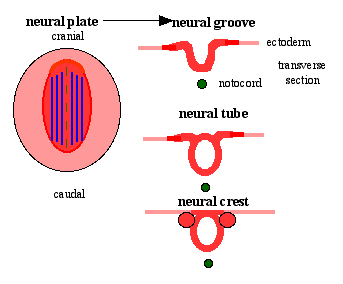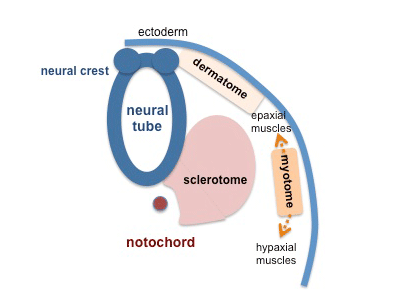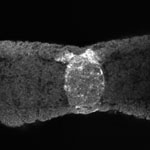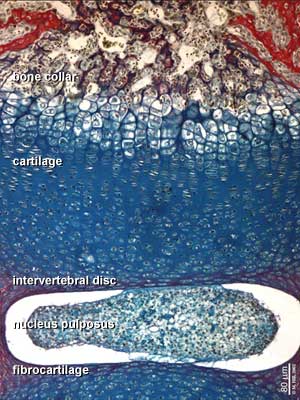Notochord: Difference between revisions
| Line 69: | Line 69: | ||
==Molecular Factors== | ==Molecular Factors== | ||
* [[Sonic Hedgehog]] | [http://www.ncbi.nlm.nih.gov/omim/600725 OMIM - SONIC HEDGEHOG; SHH] | |||
* [http://www.ncbi.nlm.nih.gov/omim/601397 OMIM - T BRACHYURY] | |||
== References == | == References == | ||
Revision as of 08:34, 3 August 2010
Introduction
The notochord (axial mesoderm, notochordal process) is the defining structure forming in all chordate embryos (taxonomic rank: phylum Chordata). It is an early forming midline structure in the trilaminar embryo mesoderm layer initially ventral to the ectoderm, then neural plate and finally neural tube. This is a transient embryonic anatomy structure, not existing in the adult, required for patterning the surrounding tissues. The patterning signal secreted by notochord cells is sonic hedgehog (shh). This secreted protein binds to receptors on target cells activating a signaling pathway involved in that tissues differentiation and development. This response appears to be concentration dependent, that is the closer to the notochord the higher the shh concentration.
Thought to have at least 2 early roles in development and later roles in patterning surrounding tissues. 1. Mechanical, influencing the folding of the early embryo; 2. Morphogenic, secreting sonic hedgehog a protein which regulates the development of surrounding tissues (neural plate, somites, endoderm and other organs).
In humans, the notochord forms in week 3, is eventually lost from vertebral regions and contributes to the nucleus pulposus of the intervertebral disc during the formation of the vertebral column.
Some Recent Findings
- Transcriptional profiling of the nucleus pulposus: say yes to notochord[1]"This editorial addresses the debate concerning the origin of adult nucleus pulposus cells in the light of profiling studies by Minogue and colleagues. In their report of several marker genes that distinguish nucleus pulposus cells from other related cell types, the authors provide novel insights into the notochordal nature of the former. Together with recently published work, their work lends support to the view that all cells present within the nucleus pulposus are derived from the notochord. Hence, the choice of an animal model for disc research should be based on considerations other than the cell loss and replacement by non-notochordal cells."
- Notochord-derived BMP antagonists inhibit endothelial cell generation and network formation[2] "Embryonic blood vessel formation is initially mediated through the sequential differentiation, migration, and assembly of endothelial cells (ECs). ...We have previously shown that the notochord is responsible for the generation and maintenance of the avascular midline and that BMP antagonists expressed by this embryonic tissue, including Noggin and Chordin, can mimic this inhibitory role. Here we report that the notochord suppresses the generation of ECs from the mesoderm both in vivo and in vitro."
Notochord Development
| File:Notochord 02 icon.jpg</wikiflv> | This animation shows the early development of the notochord occurring during week 3 of human development.
This is a dorsal view of the embryonic disc, caudal (tail and connecting stalk end) to the bottom and rostral (head end) to the top. The indentations show the location of the cloacal (bottom) and buccopharyngeal (top) membranes. The raised region in the middle of the embryonic disc is the primitive node (Hensen's node). The right hand side of the gastrulating embryonic disc is removed to the midline to show the the position of the initial axial process (purple). As the animation plays the axial process extends rostrally from the primitive node towards the buccopharyngeal membrane, where it stops. A cross-section view above the primitive node is shown in the second animation below.
|
|
|
The view is a cross-section showing how the axial process initially is formed, then fused with the endoderm, to finally separate as a midline mesoderm structure.
Yellow - endoderm | Purple - axial process
Links: Quicktime version | Development Animation - Notochord |
Patterning

|

|
| Neural tube patterning | Somite patterning |
Nucleus Pulposus
Molecular Factors
References
Reviews
<pubmed>20568241</pubmed>
Articles
<pubmed>20565707</pubmed> <pubmed>20041163</pubmed> <pubmed>19997509</pubmed> <pubmed>18629866</pubmed>
Search PubMed
Search NLM Online Textbooks: "Notochord" : Developmental Biology | The Cell- A molecular Approach | Molecular Biology of the Cell | Endocrinology
Search Pubmed: Notochord
External Links
- OMIM SONIC HEDGEHOG; SHH | T BRACHYURY
Glossary Links
- Glossary: A | B | C | D | E | F | G | H | I | J | K | L | M | N | O | P | Q | R | S | T | U | V | W | X | Y | Z | Numbers | Symbols | Term Link
Cite this page: Hill, M.A. (2024, May 4) Embryology Notochord. Retrieved from https://embryology.med.unsw.edu.au/embryology/index.php/Notochord
- © Dr Mark Hill 2024, UNSW Embryology ISBN: 978 0 7334 2609 4 - UNSW CRICOS Provider Code No. 00098G


